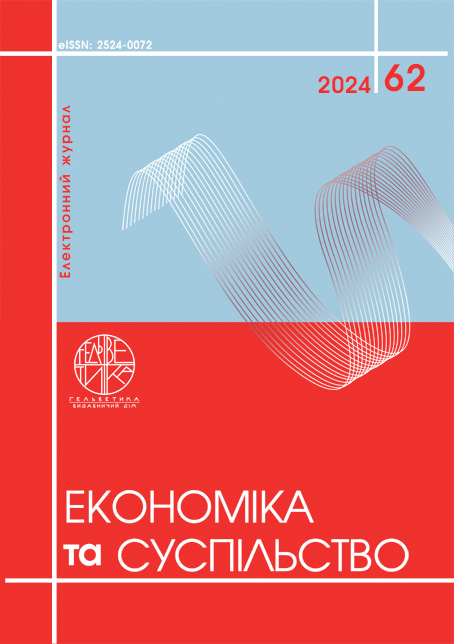USING THE PRINCIPLES OF CIRCULAR ECONOMY AND CLOSED LOOPS IN PRODUCTION TO MINIMIZE WASTE AND REDUCE THE BURDEN ON THE ENVIRONMENT
Abstract
The article is devoted to a critical analysis of linear production and consumption models and the justification of the need to move to alternative approaches based on the principles of the circular economy and closed cycles. The purpose of the study is to identify the shortcomings of linear models through the prism of resource and waste components, to review the conceptual foundations of the circular economy, its fundamental principles and prospects for implementation in Ukrainian realities. The relevance of the topic is due to the urgent need to minimize waste and environmental impact, resource conservation, and increase the environmental and economic efficiency of the national economy. The methods of critical analysis and systematic approach, SWOT analysis, and prospective analysis of potential effects are used in the study. The results of the study show that linear models determine the depletion of resources, pollution, and the aggravation of the environmental crisis, while the principles of circularity (reuse, remanufacturing, recycling, ecodesign, etc.) form an economic system close to natural cycles. Ukraine has significant potential for implementing circular practices in resource-intensive industries. The transition to a circular economy will reduce the negative impact on the environment, achieve resource conservation, stimulate the development of green technologies and new jobs, and gain competitive advantages in foreign markets. In addition to direct economic benefits, the transition to circular production models will have important positive externalities for the environment and society as a whole. This includes the protection and restoration of ecosystems, conservation of biodiversity, minimization of pollution, and improvement of the quality of life. The practical value of the article lies in the substantiation of the need to transform linear economic models in Ukraine and the emphasis on the opportunities and benefits of circularization of production processes to ensure sustainable development.
References
Machacek E., Richter J. L., Lane R. Governance and risk-value constructions inclosing loops of rare earth elements in global value chains. Resources. 2017. Vol. 6(4). рр. 59. DOI: https://doi.org/10.3390/resources6040059.
Mostaghela R., Chirumalla K. Role of customers in circular business models. Journal of Business Research. 2021. Vol. 127. рр. 35–44.
Laurenti R., Singh J., Frostell B., Sinha R., Binder C. R. The socio-economic embeddedness of the circular economy: an integrative framework. Sustainability. 2018. Vol. 10(7). рр. 21–29. DOI: https://doi.org/10.3390/su10072129.
Aleksić A., Jovanović-Vujatović M., Veselinović N. Sustainability and product life cycle in circular economy. Economics of Sustainable Development. 2023. Vol. 7(1), рр. 29–38. DOI: https://doi.org/10.5937/esd2301029a.
Jiang J., Qu L. Evolution and emerging trends of sustainability in manufacturing based on literature visualization analysis. IEEE Access. 2020. Vol. 8. DOI: https://doi.org/10.1109/access.2020.3006582.
Wiesmeth H. Systemic change: the complexity of business in a circular economy. Foresight and STI Governance. 2020. Vol. 14(4). рр. 47–60. DOI: https://doi.org/10.17323/2500-2597.2020.4.47.60.
Гахович Н. Г., Кушніренко О. М., Зарудна О. С. Циркулярна економіка як стратегічний пріоритет розвитку глобальних ланцюгів доданої вартості. Економічний вісник Хмельницького університету. 2020. Вип. 46. С. 103–115.
Гурочкіна В.В., Будзинська М.С. Циркулярна економіка: Українські реалії та можливості для промислових підприємств. Економічний вісник. Серія: фінанси, облік, оподаткування. Ірпінь. 2020. Вип. 5. С. 52–56.
Šalgovičová J., and Ušák P. (2021) The impact of the global crisis on external communication in the circular economy. SHS Web of Conferences, vol. 92. DOI: https://doi.org/10.1051/shsconf/20219205024.
Mostaghela R., Chirumalla K. (2021) Role of customers in circular business models. Journal of Business Research, Vol. 127, C. 35–44.
Laurenti R., Singh J., Frostell B., Sinha R. and Binder, C. R. (2018), The socio-economic embeddedness of the circular economy: an integrative framework. Sustainability, vol. 10(7). DOI: https://doi.org/10.3390/su10072129.
Aleksić A., Jovanović-Vujatović M.and Veselinović N. (2023) Sustainability and product life cycle in circular economy. Economics of Sustainable Development, vol. 7(1), рр. 29–38. DOI: https://doi.org/10.5937/esd2301029a.
Jiang J. and Qu L. (2020) Evolution and emerging trends of sustainability in manufacturing based on literature visualization analysis. IEEE Access, vol. 8. https://doi.org/10.1109/access.2020.3006582.
Wiesmeth H. (2020) Systemic change: the complexity of business in a circular economy. Foresight and STI Governance, vol. 14(4), рр. 47–60. DOI: https://doi.org/10.17323/2500-2597.2020.4.47.60.
Hakhovych N. H., Kushnirenko O. M., Zarudna O. S. (2020) Tsyrkuliarna ekonomika yak stratehichnyi priorytet rozvytku hlobalnykh lantsiuhiv dodanoi vartosti [Circular economy as a strategic priority for the Vol. 46, рр. 103–115.
Hurochkina V.V., Budzynska M.S. (2020) Tsyrkuliarna ekonomika: Ukrainski realii ta mozhlyvosti dlia promyslovykh pidpryiemstv [Circular economy: Ukrainian realities and opportunities for industrial enterprises]. Ekonomichnyi visnyk. Seriia: finansy, oblik, opodatkuvannia, Irpin, vol. 5, рр. 52–56.


